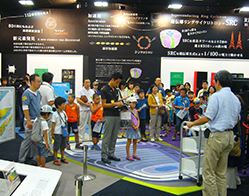
As RIKEN is a purely research-oriented laboratory, rather than an educational institution, it’s fairly unusual to see high school students—let alone elementary schoolchildren—on campus. On Friday, August 30, though, a group of 33 visitors, including elementary and junior high students ranging in age from 6 to 14, was welcomed onto the Wako campus and given tours of the RIBF accelerator facility at the Nishina Center as well as the RICC supercomputer and its popular 4D theater.
The tour began with an explanation of RIKEN at the Gallery, and then the children, most accompanied by mothers or fathers, trekked in the sweltering August heat to the nearby Nishina Center, where they were taken down into the cool underground facility. They got a chance to see the gigantic superconducting ring cyclotron, which, they were told, weighs twice as much as the Tokyo Tower. One of the children asked whether the colors of the machine (pastel green and purple) were taken from Unit 01 in the popular Evangelion animation series (they aren’t, but they do look suspiciously similar!). Some were also interested in how much the facility cost (quite a lot) and whether Dr. Yasushi Watanabe, who gave the introduction, was going to win a Nobel Prize (hard to say!). One of the highlights of the visit was a chance to see the various radiation detectors used in the facility and to see how various materials, including wood, steel, and lead, stop the passage of radiation.
They then went to the Advanced Computing and Communications Center’s 4D theater, where they got to see 4D (3D plus the ability to go back and forward in time) simulations of air currents flowing over a Nissan Fairlady Z and a flying baseball, as well as to go into the actual supercomputer room and look at the blinking lights in a darkened room filled with stacks of computers.
For the Public Relations Office, this was the first visit specifically targeted at elementary and junior high school students, and the presenters did a good job in presenting difficult concepts in a way that could be understood by youngsters without much of a background in nuclear physics or supercomputing.
